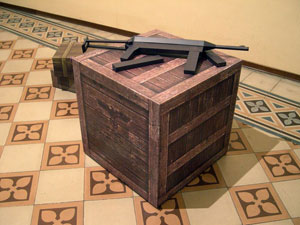
Mission 2 (Damiano Colacito, 2006)
Damiano Colacito - Born in Atri (TE) in 1973, Damiano Colacito focuses his work on the basic elements of the contemporary media landscape and the complex relationship between the virtual and the real. In the last few years he devoted himself to the creation of wooden sculptures that portray objects coming from the FPS, such as med-kits, power-ups, weapons, and etc. The Scotchprint skins he puts on the sculptures allows the author to work on details so to obtain a pretty refined reproduction of the texture of those virtual objects, and the use of sound effects, every now and then, makes the realism of the reproduction even finer. As a Pino Pascali of the Doom generation, Colacito creates conceptual sculptures that result to be amazing for both the gamer and the people who don't play videogames: the former comes across familiar objects in the wrong context,while the second has to deal with unfamiliar objects seemingly coming from another world and culture. Somehow, Colacito orchestrates a kind of mental teletransport, and materializes the insubstantial nature of the electric energy. - Domenico Quaranta
Profile: Damiano Colacito
by Matteo Bittantihttp://www.videoludica.com/news.php?news=448
Damiano Colacito is an Italian artists whose production deals with the contemporary mediascape and the intersections between technology, media, and society. His latest series of artworks, Wolfenstein's Halftrack is a recreation of game objects into real spaces. Colacito recently presented his works at the "Imagined Landscapes Symposium" (Centre for Landscape & Environmental Arts Research, Cumbria Institute of the Arts, Carlise, UK, Oct 26-27).. Similarly to Aram Bartholl, Colacito creates epistemological short circuits by introducing game elements, objects, and structure into real-life environments, as demonstrated by his series on id's Wolfenstein.
Artist's statement
"The starting point for this reflection is commonly referred to with the oxymoron Virtual Reality; but if talking about Virtual Reality means discussing space and time, or examining the model of reality of human culture from the XXI century AD, then the object of this speculation is that of constructing a representation of reality and determining the links with the vast world of sensitive impressions.At the end of the XIX century, Karl Person wrote that time and space are "ways to perceive things". In this way he intended to declare that space and time are representations which exist in a given view of the world.
However, every human model of the world possesses a structure which is distinctly two-party: one part concerns issues of a mechanic, geometric and physical nature while the other is connected to things like objectives, meanings and social issues. This dualism is at the origin of this so called "mind-body problem". In fact, the belief of Man of possessing a separate mind and body is just a conventional way of expressing the approximately two-party aspects of the model of itself. At the dawn of the third millennium AD, the geometry of the Internet and the direct perception of the information flow in the metaphoric mental space of Virtual Reality would seem to propose an end to this dimorphism." (Damiano Colacito, from Imagined Landscapes)
Videogames slowly assimilate the world, transforming objects in tri-dimensional models. Colacito's objects flee from the territories of virtual reality and materialise themselves in actual reality. Observing them one experiences a perceptive short circuit, immersed in a space-time crosswords. In fact it is constructed - on both sides of the monitor - by solid polygons covered in texture-mapping.
Critics' comments
"Colacito's objects respond to the need-shared by critics and by the market- of freeing digital art products out from the immaterial monitor , giving the manufactured artwork back to the art market.
(Antonio Cioffi)"His works should not be considered as daily impromptu objects, contextualised in the exhibition space in which they are presented, but as sublimation of the virtual universe to which they belong. What is fascinating is the idea of materialisation by a part of men's obsessions. We try and imagine a world populated by forms which intrude on our thoughts, it would be like walking on a threshold of our spectres [...]
(Veronica Gualtiero, from Imagined Landscapes).

Mission 2 (Damiano Colacito, 2006)

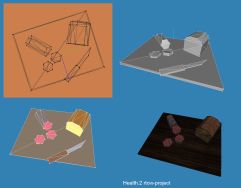
Pane e salame (Power-up) (Damiano Colacito, 2006). Legno, 3M scotchprint
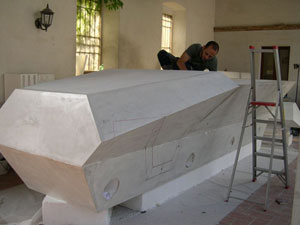
Colacito at work on the Halftrack (2005)
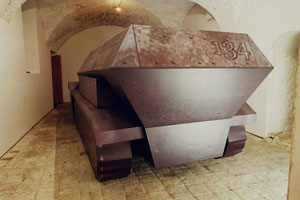
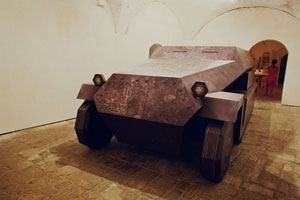
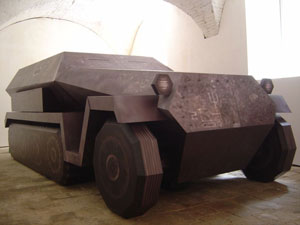
Wolfenstein's Halftrack (Damiano Colacito, 2005)
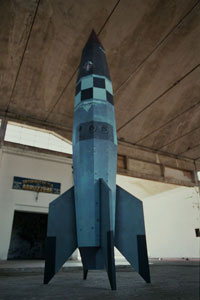
V2 Rocket Test (Damiano Colacito, 2006)

Health-Bag (Damiano Colacito, 2005)
Interview: Damiano Colacito
by Matteo Bittanti
http://www.videoludica.com/news.php?news=475&lang=en
As you might have noticed, lately we've been obsessing over Damiano Colacito's artworks. Colacito is an Italian artist who investigates the cultural and social intersections between media, technology, and society. His most recent works use videogames as a point of departure and arrival for a 360° examination on contemporary culture. We spoke to Damiano about art, the aroma of videogames, and, obviously, holomovement.
Who is Damiano Colacito? What does he do? And, above all, why does he do it?
Damiano Colacito was born on April 7, 1973 in Atri (Teramo), and lives and works in Pescara and Bologna. He is involved in art, multimedia, and teaching. On October 20, 2006 he flew over the English Channel on a Spitfire Mk V, intercepted and shot down three Heinkel-111 bombers and two German jets. The performance of that model of Rolls Royce Merlin motor was so outstanding and the interior of the plane so extraordinarily comfortable that I wanted to have an identical model in the same proportions in my garden. WWII, which we thought we had retired to history, is not really over; in Europe millions of people lose their lives in combat every night. How did we get to this point? My generation - I mean, those of us who are in our 30s and 40s today - were promised - and this was constantly reinforced through television and movies - a future packed with revolutionary technical inventions.
A new world, perhaps darker and more polluted than that envisioned by Kubrick's Space Odyssey, but equally prodigious: a world full of flying machines, robots, star ships, teleporting, and cyborgs. The miraculous change took place around the end of the millennium; like a thousand years before, the commemoration of Christ's birth again proved the turning point: the end of one world and the birth of another. It seems to me that those promises have come true only on a preliminary, superficial view. It wasn't a mistake, that world was really just around the corner, but at the time - due to a formal roughness - that world was thought to be made of solid material. Thus the only fault in that notion is that it was conceived in a historical period when practically the entire tangible world was composed of atomic material. Manipulating physical materials made of atoms is a difficult process that has to come to terms with the physical limits of the material. The price that had to be paid for that desired future was thus the sacrifice of its material covering: dematerializing corporeality almost as foreshadowed by Star-Trek's teleporting technique - perhaps the first real metaphor for digitalization.
Information technology slowly dissolves the reality around us; it eliminates the material vehicle and strips it down to the essence itself. What is returned is a transcription in binary code of the original object. Five years beforehand I was teleporting to a space station on Mars: my body could move, I could see my hands right in front of me, I opened doors and wandered hallways. I wasn't alone, there were millions of us, it was 1995 and the promise had been kept: that reality, the first of many, was - only superficially - called a videogame. It was called Doom. Today almost all of my work is focused on observing and reproducing the constitutive elements of these new and popular virtual realities into the real world. Teleporting is reversed and with difficulty and handicraft man, who now imitates the machine, gives new objects to the world, often born beyond the monitor, bestowing them with an earthly statute and frailty. Materializing the impalpable nature of electric energy.
What is your relationship with the medium of the videogame? Do you play? How and when?
At age ten I was given a Commodore 64 - do you remember those amazing machines? A grey keyboard hooked up to the antenna cable of your TV (like an IV to a dying person). That same year Wargames was released in the movie theatres, and much to my parents' dismay, the only thing I found interesting, fascinating and magnetic about the C64 was playing for entire afternoons, visualizing in the television's bubble not the usual RAI television shows, but my actions in the game world. I still find myself playing it today; I think I'm a game purist: I only play on a PC, with a mouse and a keyboard. As a loyal follower of DirectX I am interested in concentrating all of the computer experiences, both recreational and not - into a single device, my PC. I always use the same controls, no matter what the subject: text, films, music, games...Concentrating the multi-media -or better, the uni-medial-binary language-in a single material container. Maybe it's just a way of keeping things in order, of taming the untameable.
There is no formal, shared definition of videogames. What is your personal definition?
I think that videogames have become something freakin' serious and that they shouldn't just be called games. Parallel worlds or existential voyages, with laws that govern them, are so complex and tangible that they often awaken senses like smell, as absurd as that may sound. I still remember the aroma of some games. In fact, the success of the images is also due to their ability to evoke senses that are not actually involved, like smell. I also believe that videogames are extremely underestimated; not so much for their contents (too often criticized by unprepared people who don't have a relationship with IT that allows for knowing how to go beyond the glass screen of the monitor), but for the complete use of technological tools that they embody.
A common mistake is treating videogames just like other media, even though they have nothing to do with them. The videogame could be defined as the only "authentic" product of the digital machine; created by it, for it. This is an important factor considering that in the moment of transition from the social use in one medium to another medium, the products bring along a suitcase full of morphological characteristics that correspond to the technical specifications of the previous medium, as in the case - within the same IT environment - of the monitor which imitates a book and the writing metaphors like "desktop" and "page".
Where does your fascination for first-person shooters come from? I am asking you this question because I am equally thrilled, although I can hardly rationalize my own fetish for the genre...
Well, let's look at this (incredibly brief) historical moment in the development of videogame technology. First of all, there is a curious and perhaps symbolic correspondence with what happened in the western figurative art world in the previous centuries, in the sense of a kind of conceptual "summary" of those events that could also correspond to the "technological summae" that the computer itself represents (constituting a convergence point for all of the media previously developed by western science). This correspondence regards the development and linguistic use of perspective. The first videogames appeared in the early '70s, and like the first experiences in medieval figurative narration, they developed their visual structure based on the metaphor of the plane, and introduced a kind of conceptual perspective in which (as in the case of Byzantine art, for example) the size of the elements is connected their importance or to a determined narrative function in the "story".
Subsequently, videogame technology followed the path of a more and more precise three-dimensional connotation and perspective in the true sense of the word, until it reached the latest generation of games, where the reconstruction of perspective is enriched by the possibility of real time movement and interaction in the virtual space generated on the screen.
The history of the development of western figuration seems thus to pass on the "temporal" plane in order to reach space, and today as it did then it seems that the obstacle should be considered simply "technological": the definition of an evolved optical/perspective paradigm and the development of chips that are strong enough to "render" (i.e. three-dimensional) on the screen in real time. This too proves that western tension is inevitably moving towards a "solidification" of the representation space, initially conceptual two-dimensional, then three-dimensional and so solidified that it verges on the extreme opposite, "virtuality".
For art historians and students of the mechanisms of perception it's obvious how the kinds of visual representation, considered to be on the border of art or in general on that of image production, are closely connected to the cultural structure of a society, to its way of understanding reality and man in his environment, or his "vision of the world". Therefore, at this point (quoting my good friend Antonio Cioffi) if we imagine a kind of visual and perceptive form that is symbolic of the post-modern condition, what image could be better than the movement in situation of 3D videogames? They conserve the symbolic trace of the modern and Renaissance subject (the point of view set against the coplanar vision of pre-modern antiquity) from which the west, which elaborates such immersive technologies, originates.
Why do you mainly cite FPS when discussing psycho-perceptive implications?
Maybe in FPS they are more acute because they involve the first person. Nonetheless all of the psycho-perceptive implications that you have when after hours of consecutive play you leave that world, go to the kitchen to get a glass of water, and still have the sensation of being there.
What happens when you bring the iconographic conventions typical of videogames to the so-called 'real-life'?
Remember what it feels like to save a game session? I don't mean the frenetic quick save, but a calm, contemplated save, the desire to bookmark that story: freeze that moment, that particular mood, so that you can go back to it again and again. I think that saving - both in the game and in real life - has therapeutic qualities: saving in the game is kind of like reassuring yourself, making sure that up to that point it's gone pretty well and that you'll pick up from there. In-game saving could be considered the closest thing to saving your soul. When I reconstruct those objects - those virtual atmospheres - in reality, it's my way of clicking "SAVE" in the real world. I determine their existence in the mundane world, I bring them into focus definitively; bringing them from bit to material, I grant them an earthly status, erasing any ambiguities regarding their dimension or form, their existence. Of course this work also is a valuable kind of exorcism for me, personally.
How have the public and the critic community reacted to your videogame works?
The general public's and critics' reactions often correspond to their knowledge of the subject matter. The reactions can be split into three main categories. The first group includes people who have no relationship with information technology, they aren't familiar with the subject that the work refers to and at best they might appreciate the craftsmanship involved in creating it. The second group is, at the moment, the bigger. It's composed of people who use computers regularly but mostly for e-mail and surfing the web. They have heard of videogames but they mainly play Solitaire on Windows; and while their reactions are interesting they don't differ much from those of the first group.
The third group is made up of people ranging in age from 10 to 40 with different - and definitely deeper - understanding of the game. When they recognize what my works portray they suddenly experience something that could be described as aesthetic reactions and impulsive infatuations, because that piece is a part of their private collection of mental objects. It's as if they undergo a perceptive short circuit...
Sometimes these reactions are violent, like when I brought a power-up into reality for the first time during a group exhibition: an artist I didn't know at the time was playing the same game that the medication in question was taken from. I wasn't there, but when he found me, he told me enthusiastically that when he saw it he walked vehemently over to it and grabbed it as if in the game, then stopped for a few seconds - the time necessary to realize where he was - and in the end he felt like he was being tricked. Like I said before, a part of his intimate world had been exhibited in public without his being aware...
The most attentive are those who-after observing what I have extracted from an FPS for a few minutes - realize that the real subject of this investigation is not the object at hand but, on the contrary, the viewers themselves, or better, their first person view...
Are you familiar with the German artist Aram Bartholl? As I saw your artworks exhibited at the "AC/DC" exhibition I could not but think of the many analogies with his most recent works, perhaps another confirmation that videogame aesthetics are stimulating similar reflections in different times and places...
I am not very familiar with Aram Bartholl's work to be honest, and yet I'm not surprised that there are many analogies between our works. From what I have read and seen, we are both investigating the symbiotic relationship between these two worlds, the digital and the virtual, we're both painting the same subject while questioning ourselves; by this I intend the means and not the final outcome, a means towards a more in-depth collective reflection.
In this case, as in other subjects investigated by painting in the past, what is interesting is the formal difference in how the object being investigated is then given back to reality. In this process there are sometimes old dynamics linked to the different cultural contexts of their origins. These are essentially different intellectual interpretations of the same reality: to be witty we could say that in this case there's a difference between Flemish and Italian styles. I'd like to meet him soon; I'm sure that talking with each other we'd both feel a little less crazy.
In an essay included in the anthology Gamers (2006), Alessandra C. wrote a part serious, part comical essay on Castle Wolfenstein 3D: "I finished Wolfenstein 3D in one night. I ate dog food to gain life points, I discovered passages full of arms and munitions and I got to the final boss at 5.20 a.m. The fight between A. Hitler and BJ Blazkowicz, stronghold of Wolfenstein vs. Texas, wasn't an epic battle, but it represented the genesis of my new imagination"(p.354) Was your reaction similar to that experienced by Alessandra C.? Can you describe your encounter with id Software's seminal FPS - and its variations, evolutions, and sequels?
I encountered Id's Doom first. I had been invited by a girl to a party at some students' house in Milan. I didn't know anyone at the party, and I showed up with a little cardboard box that I had made, in which I had hidden a tape recorder which I usually used to tape lectures at my university. When people asked me what was in the box I avoided the subject, saying that it was a present for the birthday girl. My idea was to give the voyeuristic soundtrack to her at the end of the night. What I taped and heard was pretty normal: guys with affected voices pitching existential ideas to girls who just wanted to be listened to.
That's when I ran into Doom: between the music and chatter there was a strange croaking, a mechanical sound I had never heard before, then all of a sudden a gunshot followed by a cry. In a bedroom being used as a closet were four or five people sitting in a semi-circle in front of a computer. They were all staring at the monitor, engrossed in the screen, yelling and jumping, like the monkeys in front of the monolith in 2001: A Space Odyssey. I spent the rest of the night there too, recording the sounds, the yells of the Imps and the people. I never gave that tape to the birthday girl. Instead I rushed home and listened to it over and over until dawn: I held in my hands the soundtrack of my initiation. Over time the tape unravelled, but Doom is omnipresent.
What kind of materials do you use for your videogame pieces?
All of the elements that make up the videogames I analyse are, and will be for a long time, made up of two distinct characterizing parts. The first is that they are virtually "sketched" like complex polygons, the second is that they're covered in an "electrical" skin, their digital clothing, known as the texture map. I had to consider and materially resolve an imitation of both of these elements in order to make the real versions of these objects believable. I started using wood (for its malleability) for the manual construction of the polygons, gluing and plastering it. I now often add metal, resin and Styrofoam to it. Finding the right covering, the "skin" for the models, took months of study and tests. In order to correctly reproduce the virtual models in the real world and to make them as similar to the originals as possible, I had to try to maintain the morphological-anatomic characteristics of the original models.
Let me explain. When you use a 3D program to build a virtual model, for example a cube, the cube is grey; it's the image, the texture map, which identifies and determines its nature. If I were to apply a texture that imitates wood, the cube would become a wooden box, adding fire it would become a burning box. In games the texture is not only "glued" onto the figures, but attached to and modified according to the forms of the figures. In the real world simply printing the texture onto a rigid support like cardboard or pvc would not work. I needed a material that could be printed with a plotter but which would allow me to reproduce the physical characteristics of the texturization process.
Something that would attach to the surface like a glove, thin and flexible. Years earlier I had used something similar in the creation of large adhesive graphics of video streaming frames from the web. I applied these prints both to the ground, in public places like the Bologna train station, and-when heated for that purpose-imprinted them onto the concave inside of large satellite dishes. This material, like Scotchprint, invented by 3M and available in many variations, was in my opinion the first painting (or covering) technique, due to its intrinsic physical qualities, not in relation to the commonly accepted dynamics of the physical world, but rather to virtual representations.
Let me give an example using a typical use of this material: years ago the space for advertisements on buses was limited to a square on the side of the bus. This is fairly normal: the painting and the frame have always been conventionally used as the place and the limit within which the representation takes place. Nowadays more and more often advertisements use the entire surface of the bus, and sometimes even the windows are included in the representation area. Thus, specifically because the process of texturing has entered into our collective imagination, just as the cube mapped with flames becomes a burning cube, the entire bus can be textured. On contemporary city streets the bus and its new advertisement "skin" fit together.
Which artists, contemporary and from the past, most fascinate you? Why?
This is a hard question, perhaps the artists that fascinate us are the ones whose works we remember most. For a few weeks I've been thinking about a painting I saw in Mantua at the "Fruttiere di Palazzo Te", an important exhibit for the 500th anniversary of Andrea Mantegna's death: "The Lamentation over the dead Christ". I had studied the courageous choices of perspective and style in this painting in the past; the reduced point of view, showing Christ lying down on the naked anointing rock (which demonstrated the respect and faith that the artist had for the evangelical indications), the maniacal attention to detail (the wounds inflicted during the crucifixion, for example), and finally the choice, which bordered on indecency at the time, of showing a lowly part of the body-his feet- at eye level and in the foreground. But in my eyes that deposition took on a totally different connotation. That little painting (68 x 81 cm) took me back to another perspective, where the feet were in the foreground, but where the point of view was reversed, so that I was no longer the witness of that dramatic scene, but rather the defenceless subject: the first time that I was lain down in a deposition.
In Quake 4, after having completed your duty as a galactic marine, you are one step from victory, the "transubstantiation" of your body with that of your avatar has been in effect for some time and you feel at ease in that virtual organism, everything seems to be going in the right direction. All of the difficulties that you have overcome and the torture of intense combat bring you to fight with the boss at the last level: but in the fight you aren't killed-you end up worse off- captured and stunned. This is a narrative choice already used in the history of videogames years before, in other games like Half-Life or Deus Ex, but this time when you wake up you aren't locked up in a detention cell, rather you are lying immobile on a cot in the enemy's medical complex, and you see your feet. You are part of a huge human production chain in which captives have cyborg components implanted in them. You are witness to and aware of the torture awaiting you. Thus, your legs amputated, your "physical" appearance disfigured and raped, you will remain- after "fortunately" being freed by your fellows- a non-human for the rest of the game. At the end of the game my obsessed mind has a question: what body did the legs that were amputated belong to? An incredibly realistic perceptive experience, just as concrete as Mantegna's simulation in giving us a "front row" view of the anointing of the dead body of God's son...
Do you know any other Italian artists who use the game as an expressive medium, other than Mauro Ceolin and Marco Cadioli?
I don't know of any other Italians who place videogames at the fulcrum of their artistic practice, but if we were to include reflections that examine digital anatomies and their appearances in the real world, an artist who deserves consideration is the painter Flavio De Marco. His painted "Paesaggi" (landscapes) delve into the spatiality of the Graphical User Interface (GUI) as a possible experience of the natural horizon. As he himself says regarding his project "Mimesi", "it's an attempt at reasoning in the category of the model and copy in the age of the binary translation of reality".
While we deal with different subjects, De Marco's and my fields of investigation share the same starting point: not to read virtual realities separately from real ones but on the contrary as acting parts of a single manifestation, of a universe in which everything is infinitely interconnected and where all of the conscious and perceptive modalities are interconnected too.
This theory was already expounded years ago by the quantum physicist David Bohm, who- in the theory of holomovement- asserted that the tangible reality of our everyday lives is a kind of illusion, a sort of holographic image. A more profound order of existence lies under this; a fundamental and vaster level of reality from which all objects and appearances of the tangible world originate. I cite Bohm often because those who criticize and fear virtual expressions actually don't know the real world well, either.
Satellite dishes, web cams and videogames: what is the contemporary mediascape according to Colacito?
I came up with the idea for my recent works in 2002-3. My work using spy cams, which had begun at the end of '98, was coming to an end; entire nights spent monitoring and photographing what was happening on the other side of the world was turning me into a regular guard in a guardhouse... Like I said before, I printed many of those images and applied them to the concave inside of satellite dishes, physically reassembling the distortion that the same images had originally shown: giving the world back the images that had been stolen from it, reconstructing-I believe-real, true mirrors.
I remember that I took all of the images that I hold the conclusive ones of that series from a single site in a final sleepless night at the end of 2000: I was really attached to that infrared cam, it was one of my first discoveries on the web and the first to restore a true icon of our time, a physically impractical image: the toilet seen from the inside of the toilet bowl. I found it ironic that the progressive miniaturization of spy cameras (the same technology that had given us the images of our planet seen as a tiny sphere lost in the universe) now showed an unedited breakthrough in perspective. What I found myself admiring was not a frescoed cupola painted by Antonio Allegri, those weren't little angels along the edges of the parapet, that parapet was simply the rim of a toilet bowl. My surfacing in the world that was virtually stuck in that bowl redefined the idea of vision I had held up to that moment.
That December night I edited all of those frames into a short video where the soundtrack was an old recording of another historic December, that of 1968 when aboard the Apollo 8 the astronaut Frank Borman saw the earth from space and wished "a merry Christmas" to all. It was the best way to leave that enormous kaleidoscope wherein the viewer is also a part of the vision, and to enter into the gigantic global vision called Video Game. My intent wasn't, and couldn't be, to add more material to the relentless "digital storm" that was going on. Just as earlier I had resisted the idea of hiding a spy cam in a public restroom, it wasn't helpful for me to build mod, entertaining myself with the Software Development Kit already linked to a good number of titles. I can say that my interest has really always focused on the relationship between the object represented and its representation. And if this period of history will be remembered from the art history perspective, it surely won't be due to the quality of representation that digital media makes of the subject "the world", but rather for its intention: to translate, mime, and relocate a large part of the visible experiences of tangible life.
The third object that I constructed from a game took me 87 consecutive days of work. After health-bag, the power-up that I mentioned earlier, and an mp40 machine gun, I needed to build something imposing, I felt an urgency to make a physically illogical gesture and choose something with weight, it couldn't be a sturdy outdoor sculpture but on the contrary, it needed to be fragile, threatened by bad weather, and should be reminiscent in its grace of a huge, beached marine cetacean. This is how Wolfenstein's Halftrack was born in 2005, sculpted out of blocks of Styrofoam along with wood, metal and resin, and completely textured.
A heavy but delicate tank that proclaimed its senseless existence and that would metaphorically carry all of the future models in its hull. An exact reproduction of the half-track present in the game it's named after, it started out weighing less than ten virtual kb, then became hundreds of real Kg. In short, the models I build are not just simple wooden toys, but signals of reactivity: reactions to this perpetual motion, like salmon swimming against the current of a digital stream. On the other hand, the iPod I was given two years ago is still sitting in its original, faded box, as I prefer to listen to 78 records of Louis Armstrong on my portable His Master's Voice N° 4 gramophone rather than their virtual translations.